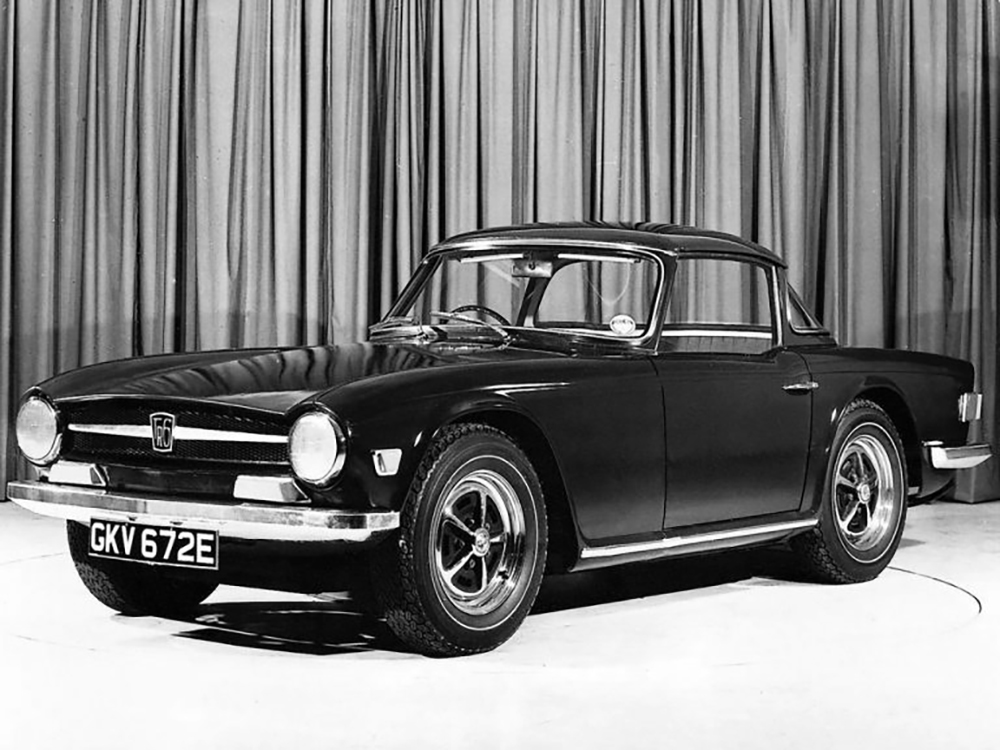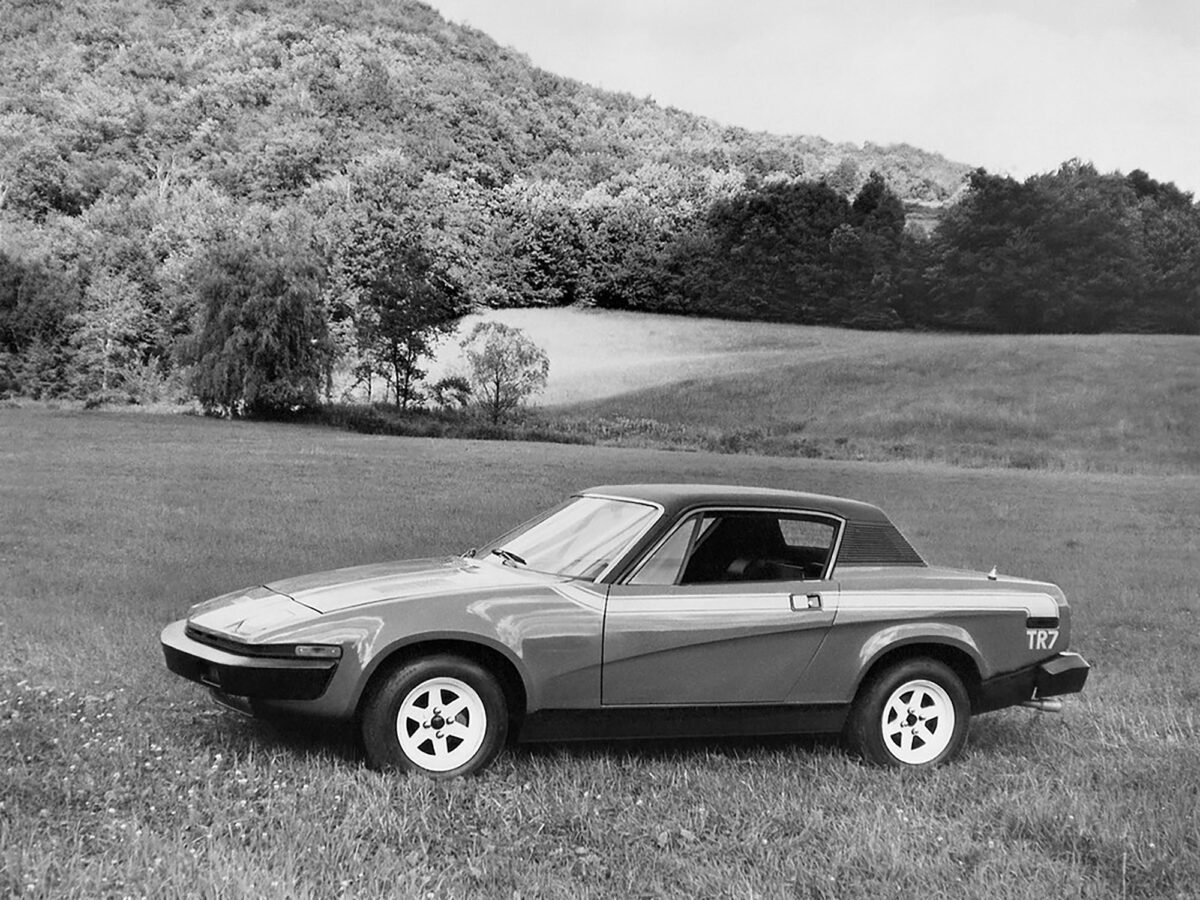Was the Triumph TR6 an all-new car?
In short, no. The TR6 offered buyers an all-new, sharper, blockier, more modern body style designed by Karmann of Germany, but was based upon the familiar chassis with the new 2.5L inline 6-cylinder engine that debuted in the TR5. But, the new style gave the car a much more muscular, aggressive look than the preceding TRs, and yet, it was a minimal effort. Because of budget constraints, the TR6 would use the same doors, windshield, and most of the body tub from the TR5 cars.
With a four-wheel independent suspension, rack-and-pinion steering, front disc brakes, and the 2.5L inline 6-cylinder engine, the TR6 was a marked improvement over other TRs. While it was very closely related to the TR4A, optional Michelin tires, rear anti-roll bars, and limited-slip differentials took the TR6 to another handling level and helped make better use of the powerful engine. Interestingly, few TR6 buyers opted their cars with these features, but the available hardtops and overdrive transmissions were very popular.
When it debuted in 1968 for the 1969 model year, it was very well received by both sportscar enthusiasts and people looking for a fun car with pep. A number of changes occurred, both subtle and more obvious, even during just the first few months – fuel injection wasn’t available until a bit later, the gauges were updated, a new front spoiler was added, and a milder cam was installed on the FI cars when they became available, dropping horsepower to 125, but making the car easier to drive in traffic.
Fuel injected cars could sprint from 0-60 in about 8-seconds and showed top speeds right at 120 MPH, confirming again that Triumph was one of the quickest and fastest production roadsters available, and one of just a handful in the price range with such an enviable roster of equipment.
How many Triumph TR6 were built?
Buyers recognized the value of the TR6, making it the most popular of the TR-series with over 90,000 units sold by the time production ceased in 1976.
Where so many European roadsters could be absolutely uncivil, the TR brought with it a sense of welcome luxury. Riding on massive tires, the ride quality was like no other, yet the taut suspension allowed for exceptional handling with plenty of room for improvements. The interior was a welcoming environment of supportive bucket seats, full carpeting, full instrumentation, and a slab of wood stretching the width of the dashboard. Couple that with a powerful 6-cylinder engine, and some people likened it to the Jaguar E-Type, Porsche 911, and Mercedes 280SL, without the sticker price. Interestingly, some even noticed the design similarities between the SL and the TR6, with a lengthy front end, blunted nose and tail, and tire sizes seemingly disproportionate to the overall size of the car.
The oft ignored Triumph TR7
Known as “The Shape of Things to Come” by advertising people of the day, the futuristically-styled TR7 was more often known as the wedge car. It’s heavily raked front end and windscreen, chiseled edges, and blunted features indeed lent it a certain space age theme.
Introduced in the United States in January of 1975, it oddly wouldn’t debut in the United Kingdom until May of 1976. The car was surrounded by a small smattering of wedge-shaped cars popular in the era, most notably the Lamborghini Countach, the Fiat X1/9, the DeTomaso Pantera, the Lotus Eclat, the Lotus Elite Types 75 and 83, and a number of others. Popular, the TR7 returned to the 4-cylinder engine with reduced power output and overall performance, but increased drivability by a wide margin. The handling and comfort characteristics were spectacular, it was a car that basically anyone could drive daily with great ease. Interestingly too, the TR7 was designed with a V-8 engine in mind.
Available as a hardtop or convertible
During its development, there was murmuring in the USA concerning rollover safety of convertibles, which caused Triumph to rethink the idea of offering strictly roadsters. The TR7 would initially be sold only as a fixed-head coupe; but, by 1979, a droptop TR7 was offered, which gave customers the big question of buying a hardtop or a convertible. Many lamented the hardtop, claiming the old removable hardtop was a fantastic idea, but again, following the legislative requirements, it was necessary to produce a solid hardtop coupe.

Is the TR7 reliable?
Like so many European sportscars, their reputation for reliability depends on who you talk to. TR7 owners often discussed head gasket failures, delicate manual transmissions, electrical troubles, and dysfunctional popup headlights, but outside of these, the TR7 seemed to serve well. Like so many European cars in North America, it’s very possible that its main trouble was lack of knowing mechanics to maintain and correct the cars, which would often result in worsening a car’s overall condition. It’s important to seek out a car that’s been well maintained, with records, by a reputable shop or mechanic, or very skilled and caring owner.
What engine did the TR7 have?
The TR7 was a step back, in some regards, the 6-cylinder of the TR6 being dropped in favor of a 2.0L inline 4-cylinder engine with either a 4-speed manual, 5-speed manual, or 3-speed automatic transmission. With 92 HP, American versions of the car were, as usual, the least powerful of the batch.
European versions of the TR7 were capable of 0-60 runs in about 10-seconds and top speeds of about 108 MPH, drastically increased from the TR6. Chassis formula was roughly the same, with front disc brakes, thick front and rear sway bars, and an independent front suspension with coil springs front and rear.
Despite the woes of 4-cylinder motoring, Triumph engineered the TR7 to accommodate an 8-cylinder engine, which would beget the TR8.
Was the TR8 the last of the TR?
Yes – the swan song for the TR was the TR8, a TR7 with a 3.5L V-8 engine, making it a very respectable performance machine. While fantasies at Triumph swirled around a resurrection of the Sunbeam Tiger and AC Cobra, the Triumph TR8 would prove to be much more relaxed than either, but an easy contender for high-powered sportscars of the era such as Chevrolet Corvette. In fact, the TR8 was often called the British Corvette. With its own unique brand of performance mixed with rebellious styling, the TR8 was a very interesting piece of Triumph and automotive history, ending production of the famed and fabled TR line very much on a high note.
What engine was used in the TR8?
The 3.5L Rover V-8 used in the TR8 was derived from an engine designed and manufactured by Buick-Oldsmobile in the 1960s. The rights to manufacture it had been sold to British Leyland and the V-8 found itself in a number of vehicles.
Interestingly, the TR8 was in development simultaneously with the TR7 in the early 1970s. However, because the V-8s were not available, supplies having gone to other makers, Triumph had to wait and sell only TR7s. The TR8 would be supplied with both carbureted and fuel injected V-8s, depending on the market and their emissions restrictions. For 1980, carbureted California cars showed 133 HP, while the fuel injected cars show 137 HP. By 1981, all North American TR8s used fuel injection and delivered 148 HP, which gave the TR8 a 0-60 time of about 8-seconds.
To cope with a slightly heavier engine, more power, and higher performance, the TR8 was equipped with heavier-duty brakes, the battery was relocated to the trunk to alleviate space and better balance the front-to-rear weight bias, the rear axle ratio was adjusted, and alloy wheels were used.
How rare is a TR8?
The TR8 is one of the rarest of the TR line, with about 2,800 TR8 coupes and convertibles being made between 1978 and 1981, with a multitude of further breakdowns available to determine some cars as rarer than others.

Are the TR7 and TR8 important?
Yes, they are important for several reasons, most obviously their rarity. While a fair number of TR7s were made, few survive – and the TR8 was a rarity from the get-go. With the rarity can come importance, but also the TR7 and TR8 were unique in that while all subsequent TRs can trace their roots back to the original TR2, the TR7 and TR8 were all new.
The TR7 and TR8 used an all-new uni-body and chassis, and the TR7 returned to the 4-cylinder formula. The smaller engine with the doorstop shape was supposed to ensure exceptional fuel efficiency, which was very important in the era.
The TR7 was the first TR, the only TR, to offer a true coupe bodystyle with a companion convertible. This, in a way, nullified the “TR” name, which stood for Triumph Roadster – after all, a full hardtop coupe is no roadster. All the previous TRs used a removable hardtop to close up their interiors, something a few customers missed.
The TR8 provided customers the opportunity of owning a true, V-8-powered sportscar, a rare treat in the very latest years of the 1970s for the price point. A truly unique vehicle, the TR8 gave customers exceptional performance and the panache of a V-8 engine – oddly, no 6-cylinder was offered. Only a 4- or 8-cylinder.